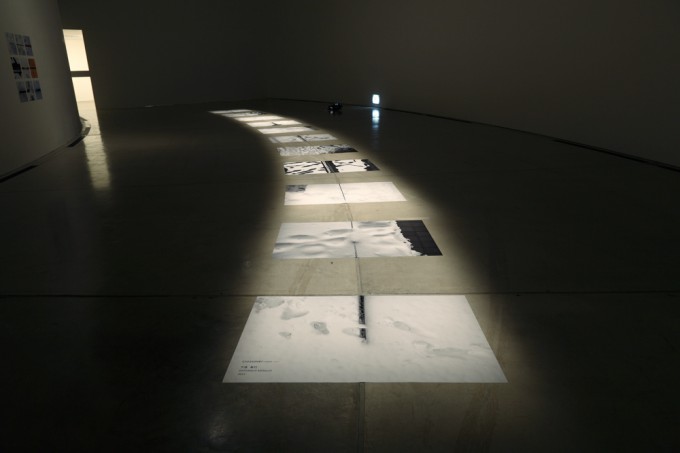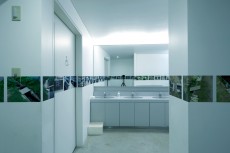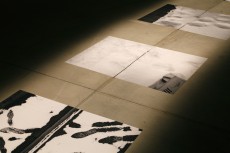
“Re-Modernologio” Phase3: Traces of Scenery
February 18 (Sun) ~ March 25 (Sun), 2012 10:00 - 18:00 / Free
SHITAMICHI Motoyuki

crossover
A-side and B-side Story of what is in between the two sides
HATTORI Hiroyuki
SHITAMICHI Motoyuki is a traveling artist. In a literal sense, he is a “traveler-type” artist who creates works while staying and living in different parts of the country, but what is more appropriate to his case is that we can grasp his creative activity more clearly when we compare it to “traveling.” Types of traveling could be roughly grouped into two kinds: one is that the final goal of the traveler is to reach the destination he has planned, and the other is that the traveler does not decide on his destination and appreciates being on the road, seeking encounters with town, people and things in the process of movement. Shitamichi pursues these two poles depending on the nature of his work. If the former type of activity/work with the definite destination (subject) is defined as “A-side” (of a record or CD), the latter type is defined as “B-side,” in which the target is not specific or the process itself is valued of observing unexpected by-products he finds as he goes towards a certain target. It seems that Shitamichi travels back and forth between the A-side and the B-side keeping a balance in order to supplement his activity of crossing the two poles. For example, he produces B-side type of pieces in the process of aiming for the A-side.
His accumulation of things that he has collected in “traveling” constitutes the main element of the formation of his works. His search and accumulation are wide-ranging: In Bunkers, war ruins scattered throughout the country are photographed, torii depicts torii (shrine gate) that remain outside present borders of Japan, Sunday painter shows his grandfather’s paintings, which he traveled looking for, and the space with them. Sunday creator displays the collection of things produced continuously by nameless creators, and in bridge, snapshots he took at different places show items of minimum structure like a piece of board connecting boundaries found everywhere, which he defined as “bridge.” At first sight, he seems to be pursuing disconnected things in a distracted way, but there are three points in common as in the following concerning those which he has collected with his sharp observing eye and curiosity.
1) They are made valuable through small personal discoveries
2) They are given a form and function through one’s acts
3) They have some sort of story or memory in the context of their formation
I’d like to discuss the subject from the above-mentioned assumption.
Bunkers, which was published in 2005 and acted as a trigger to draw attention to his work, captures the present state of war ruins such as a pillbox, artillery battery, and aircraft bunker built for military purposes. Some bunker is now used as someone’s dwelling, and the base of some artillery battery has been transformed into a flower garden. Thus, by capturing situations which continue to exist as revived scenery remarkably transformed after being totally deprived of the military function, he visualizes the fact that the wartime of only some decades ago and the present time are connected adjacently, or he expresses clearly human originality, creativity and vitality that arise out of necessity. Presenting the landscape, he makes us think of a diversity of histories and stories behind the scenes.
The torii series contains photos of existing torii, which suggest that Japanese people once lived outside the present borders. They are not necessarily intended to display Japan’s history of conquest, but they provide a sign that Japanese people lived there for various reasons like Japanese emigrants who formed a Japanese quarter. One of the torii left with the surface painted snow-white is surrounded by Christian gravestones while another torii is pulled down and used as a bench. They are thus given totally new functions and values by people living there today and make new landscape.
As “war ruins” and “torii” collected in Bunkers and torii respectively have stayed at the same place over many years, their powerful presence appeals to us whatever conversion might be made. Each is definitely an A-side type of work, because he intentionally searched for and captured its great existence located at a specific place. Although none of them is a well-known monument, they have the power of existence, and are made into artworks following the orthodox rule of photography, that is, to make the subject into a monument by pursuing it as the target.
On the other hand, his important B-side type of work is probably RIDER HOUSE . When he made a trip around Hokkaido for the production of Bunkers, he stayed at a “rider house,” a lodging for bikers, which he thought was interesting and began its collection of pictures. What interested him was, for example, that each rider house had its own established rules or there were encounters with sojourners from different backgrounds. As the situation itself was interesting, he took snapshots of people he encountered at rider houses, took pictures of their lives and saved them up behind his job of photographing war ruins. Groups of such photos of RIDER HOUSE, which captured the hidden side of the trip for Bunkers, show us vividly of Shitamichi’s daily life at the time as well as the riders’ lifestyle. This is exactly B-side type of work attracting us by its behind-the-scenes appeal.
For the exhibition at ACAC, crossover, a new residency production in Aomori and bridge that was produced last year and reconstructed anew have been combined, so that his recent B-side type of activities are in spotlight. What the two works share in common is that certain acts of people have given them a form and meaning. As to crossover, it has stemmed from his experience in the past when he found a road and took a photo of that road, which was formed by traces of people’s acts─people and animals walked back and forth along the path where there was originally no road, and grass stopped growing. The surface of the earth began to appear and finally a road-like strip of ground was left there. As an extension of this approach, he collected, while walking through snowy places in Aomori, such a road as formed by footprints around a small bar set up on a lot between a supermarket and the street or at borderlines between two different parts of land which people stepped across. When people step across a bar partly buried in snow, their footprints are left on both sides of it. When other people see those footprints, they begin to cross it there, and as a result, what appeared to be a path becomes a real road. Meanings and functions are given through the engraved traces of people’s acts.
In order to position the bar in the center, Shitamichi held his camera right above it, and photographed roads formed by traces and collected them. Rather than searching for the specific site of such a road, he must have discovered them in the process of daily living. Though it is possible that they exist all over the place, it is difficult to actually look for them, because their conditions are constantly changing: they appear someday but disappear some other day depending on the circumstances of snowfall and snow removal. This act of cutting out and collecting those roads, which he happens to encounter in his everyday life is quite a B-side type of work.
As to his way of exhibiting what he discovered and collected, he pays attention to the smallest detail. Although, on most occasions, photos are framed or mounted for display on a wall, he decides on how to display them depending on the quality of the subject that he has captured in the photo. For “crossover,” in which “roads” discovered in his travel are photographed by his digital camera like snapshots, eleven pieces in total are printed in monochrome of the size 123.5x83cm and pasted directly on the corridor-shaped floor of gallery A with spray glue. And a projector showed 35mm positive film slides, which captured the moment when a person seen from the front stepped over a bar, in a small size on the wall.
In the inner part of the exhibition room is bridge. This collection contains what he defined as “bridge,” those of minimum structure, which can be seen everywhere connecting this side and that side. Shitamichi noticed them while traveling around all over the country on his motorcycle from March through August 2011. They are, for example, a log put across a waterway between the footpaths of fields, bricks and concrete blocks placed quietly to remove the level difference between a garage and the road, or a board to moor a boat alongside the quay. Though their roles present an infinite variety, he calls the minimum structure connecting little gaps “bridge,” and has found delight in an amusing quality in the landscape transformed by modest creativity coming out of necessity in our daily life. A total of 280 pieces of “bridge” is printed in size A4 along with the shooting date. They are arranged in a single horizontal row on all four sides of the wall in the exhibition room, and go further across the passageway, washroom, etc. pasted with spray glue on a line of the same height. On a table placed on the center of the exhibition room are a map of Aomori city with a plot of roads discovered by him, and a map of Japan with marked traces of his motorcycle tour to photograph “bridge,” which took him about half a year. Here, his intention of putting crossover and bridge in the same category is explicit. The medium that Shitamichi mainly uses is photography, but by displaying items like maps, which remind us of his trips as object, he tries to present his works from all angles so that viewers can picture a story behind each photo of “road” and “bridge.” His way of spatial composition to value this sort of process and his choice of quantitative and improvisatorial merits of a digital camera show a great deal his B-side type of attitude. What he would not do is to select only photogenic “road” and “bridge,” enlarge them, put them in frames and arrange them on the wall in neat order. His way, on the other hand, seems to be “loose” or “aggressive” at first glance, because, for instance, he pastes his works directly on the floor or continues pasting them on the walls on and on. By boldly putting what is usually thrown away as a surplus along with photos, he encourages us to search for our memories hidden behind surplus parts including such discoveries.
The fun that the B-side type of world presents to us is not to rush to the destination on a superhighway, but, to make various unexpected discoveries while moving around lazily along small roads (let me share his name Shitamichi: shita=under, michi=road with him), stopping off at different places to enjoy changing landscape. No doubt it is important for us to push forward intently to the definite goal, but it is also indispensable for us to have time to make a detour to experience and absorb what we did not intend to do. Keeping a balance by smoothly connecting the A-side with the B-side, Shitamichi is intensifying his expression slowly but steadily.

bridge Installation view

bridge Installation view

crossover Installation view

crossover Installation view
「再考現学 / Re-Modernologio」pahse3:痕跡の風景
2012年2月18日(土)~3月25日(日) 10:00 - 18:00/無料
air2011-4ja
下道基行
SHITAMICHI Motoyuki

《crossover》全景
A面とB面、そしてそれらを結ぶ余白の物語
服部浩之
下道基行は旅するアーティストだ。文字通り各地に滞在し生活するなかで作品を制作する「旅人型」という意味もあるが、それ以上に「旅」に喩えることで、その創作活動は非常に捉え易くなる。旅は、ある明確な目的地を設定しそこに到達することを最終目標とするタイプのものと、 具体的な目的地は定めず移動すること自体や移動の過程での街・人・ものとの出会いなどを求めるものの、大きく2通りに区分できるだろう。下道は作品の質に応じてこの「旅」の両極を探求し作品として提示する。ここで、レコードやCDのA面曲/B面曲という構成を範として、前者のような明確な目的地(対象)を 目指す活動/作品を「A面」、後者のように具体的な目的は明瞭でなかったり、何らかの目標へ向かう過程で発生する副産物的なものに着目するプロセス自体に重点を置く活動/作品を「B面」と定義すると、下道はときにA面を目指す過程でB面的な作品を生んだりと、A面/B面を往来することによりバランスを保ち、自身の両極を横断する活動を補完しているように思われる。
また「旅」での蒐集物が彼の作品を形成する主要素となる。その探求蒐集は多岐に渡り、全国各地に点在する戦争遺構を撮影した≪戦争のかたち≫、現在の日本の国境の外側に存在する鳥居を捉 えた≪torii≫、祖父が描いた絵画の行方を追いその絵と設置された空間を写す≪日曜画家/Sunday painter≫、無名の創造者が日々つくり続ける創作物を蒐集する≪Sunday creators≫、どこにでもある境界をつなげる一枚の板など最小限の構造物を「橋」と定義し各地でスナップした≪bridge≫など、 一見散漫な興味のもとバラバラなものを追っているように思われる。しかし下道が鋭い観察眼と好奇心をもって発見し愛でるように蒐集するものには、下記三項目の共通点がある。
1)極めて個人的でささやかな発見により価値を与えられるもの
2)人の行為によりかたちや機能を与えられたもの
3)その成立の背景に何らかの物語や記憶を備えているもの
以上の前提のもと論考を進める。下道が注目されるきっかけとなった2005年に出版された彼の著書『戦争のかたち』は、日本全国に多数現存するトーチカや砲台跡、掩体壕など軍事目的で建造された戦争遺構の現在の様子を捉えたものだ。ある掩体壕は住居として人が暮らしていたり、ある砲台の台座は花壇になっていたりと、かつて与えられた軍事機能を完全に剥奪され鮮やかに転用された新しい風景として存続し定着している状況を捉えることで、戦争 が起こっていたほんの少し昔と現在は地続きでつながっているということを可視化したり、あるいは必要から生じる人間の創意工夫のちからや生活力を明示するなど、その風景を提示することで背後に存在する様々な歴史や物語を私達に想像させる。
また、現在規定されている日本の国境線の外側にかつて日本人の生活が存在した痕跡を示すように現存する鳥居を写真で蒐集したのが≪torii≫というシリーズだ。これらは必ずしも日本の征服の歴史を示すものではなく、移民として日本人街が形成されるなど、様々な理由で日本人が暮らした場所やその生活の存在を証すものだ。ある鳥居は周囲をキリスト教の墓標に囲まれ表面を純白に覆われた状態で残っていたり、別のものは鳥居本体がその場に倒されベンチのように利用されていたりと、現在そこで生活する人の手により全く新しい機能や価値を与えられ、新たな風景を形成している。
≪戦争のかたち≫や≪torii≫で蒐集される「戦争遺構」や「鳥居」は、ともに永い年月をかけてひとつの場所に鎮座していることもあり、どんな変換が施されようがその存在感は非常に強力だ。そしてこれらは特定の場所に位置するその強烈な存在を求め捉えるという極めて「A面」的な作品だ。どちらもその対象は決して著名なモニュメントではないが、存在の強さはあり、それを目的として探求することでモニュメント化をする正統的な写真の作法により作品化されている。
一方で「B面」の代表的な作品は≪RIDER HOUSE≫だろう。これは≪戦争のかたち≫の制作のために北海道を旅した下道がバイカーのための宿「ライダーハウス」に宿泊したことで、 その面白さを発見し蒐集したものだ。宿ごとに形成される独自ルールや空間があったり、そこに滞在する多様なバックグラウンドをもつ人々に出会ったりと、その状況自体が下道には興味深く感じられ、戦争遺構の撮影の裏側で、ライダーハウスで出会う人やその生活をスナップ的に撮り溜めていたそうだ。≪戦争のかたち≫のための旅の裏側を捉えた≪RIDER HOUSE≫の写真群は、その当時の下道の日々やライダーたちの生態が想起されるものがあり、その裏側的魅力に惹き付けられるまさにB面的作品となっている。
ACACでは、青森での滞在制作による新作≪crossover≫と昨年制作した ≪bridge≫を再構成し両者を接続することで、ここ最近の「B面」的な活動に焦点を当てる展示となった。これらに共通するのは、人の何らかの行為により意味やかたちを与えられたものということだ。≪crossover≫は、元々道路などなかったところを人や動物が往来することにより、そこだけ植物が途絶え土が顔を出して通路らしきものが生まれるなどの行為の痕跡によってかたちになる道を発見し撮影していたことに由来する。その延長線上で、雪の青森を散策するなかで、スーパーと道路の境界に設置された敷地を仕切るちょっとしたバーなど、あちらとこちらを隔てる小さな境界線を人が跨いで超えることにより足跡が残り姿をあらわす道を捉え蒐集したものだ。雪に半分埋もれたバーを人が超え横切ると、そのバーの両側に足跡が残る。足跡が残ると他の人もそこを横切るようになり、やがてその道らしきものはより鮮明な道になる。人の行為の痕跡が刻まれることで、そこに意味や機能が与えられていくのだ。
下道は、バーが中央にくるようにその真上にカメラを構え、痕跡による道を捉え蒐集した。これらの道は、所在が明確なものを探し求めていくというよりは、生 活する過程で発見されたものだろう。実際それは降雪の具合や除雪によってある日は存在していたが別の日には消滅しているという、あちこちに存在の可能性はあるが、それを求めて捉えるというのはなかなか困難な、絶えず変化する存在だ。この日々の生活において偶然出会う道を切り取り拾い集める行為も、極めてB面的ではなかろうか。
また、下道は発見し蒐集したものを公開する作品化の方法にもとても細やかに神経を遣う。 写真は額装やマウントにより壁に掛けて見せるのが常套手段だが、彼はその写真が捉えるものの質により提示法を決定する。移動の過程で発見した「道」をデジタルカメラで撮影するというスナップ感覚の強い≪crossover≫は、計11点を123.5x83cmの大きさでモノクロプリントしギャラリーAの回廊状の床にスプレー糊で直貼りするスタイルをとった。そして壁面にはスライドプロジェクターで、人がバーを超える瞬間を正面から捉えた35mmのポジフィルムによるスライドを小さく投影した。
その奥の展示室には≪bridge≫が設置されている。これは2011年3月~8月にかけて下道がバイクで日本全国を巡るなかで、どこにでも目に入るあちらとこちらをつなぐ最小限の構造物を「橋」と定義し蒐集 したものだ。例えば、水路を挟んだ田畑のあぜ道に渡された一本の丸太や、車庫と道路の段差を解消すべく道路にちょこんと据えられたレンガやコンクリートブ ロック、あるいは岸壁と船をつなぐ渡し板など、その役割は千差万別だが小さな隔たりをつなげる最小限の構造物を彼は「橋」と呼び、必要が生む日常生活にお けるささやかな創造性により変容される風景に面白みを発見した。計280点の「橋」はA4サイズの紙に撮影日とともにプリントされ、展示室壁面の四周を一 列に横切り、さらに展示室からはみ出して通路やトイレも横断しひたすらひとつのライン上にスプレー糊で貼られている。展示室中央に設置されたテーブルには、彼が発見した道をプロットした青森市の地図と、約半年かけて「橋」を撮影しながらバイクで巡った旅路をマジックでなぞった日本地図が設置されており、 ≪crossover≫と≪bridge≫を同列に並べる思考が明快に見てとれる。下道は写真を主なメディウムとするが、それだけでなく地図など旅のプロセスを想起させるアイテムをオブジェとして陳列することで、私達鑑賞者がその「道」や「橋」の写真一枚一枚の背後にあるストーリーを想像できるように立体的に提示しようと試みる。こういうプロセスに価値を置く空間の構成法や、デジタルカメラだからこその物量や即興性を敢えて選択することも極めてB面的な態度と言えよう。フォトジェニックな「道」や「橋」を数点選んで大きく引き延ばして額装し整然と壁に並べるのではなく、床に直接貼る事や、壁に延々と貼り続けるという、一見「ゆるい」とか「強引」と思われるような手法をとり、写真以外の通常は余剰として切り捨てられてしまうものを敢えて併置することで、その余剰も含めてその発見の背後にある記憶を探求することを奨励する。
B面的世界の面白さは、下道の名前にあやかるなら、高速道路を一直線で目的地に向かうのではなく、変化する風景を感じながら寄り道を重ね下道をのんびりと移動する過程で、思いもよらぬ様々な発見をすることにあるだろう。確かに明確な目標を据えそれに向かって一心不乱に突き進むことも重要だが、時には少しその道を外れ遠回りをするゆとりを持ち、意図しなかったものを吸収していくことも不可欠ではないか。下道はこのA面/B面の両面をしなやかに接続することでバランスをとり、その表現の強度をゆるやかだけれども着実に醸成している。

《bridge》展示風景

《bridge》展示風景

《crossover》展示風景

《crossover》展示風景
